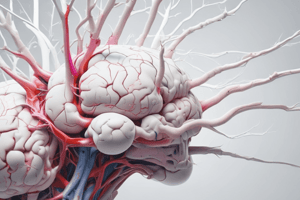Podcast
Questions and Answers
What is the function of the cerebral cortex?
What is the function of the cerebral cortex?
- Facilitates coordination of movement
- Connects the two hemispheres of the brain
- Responsible for higher-level functions (correct)
- Regulates involuntary actions like heartbeat
Which of the following structures is mainly involved in motor control?
Which of the following structures is mainly involved in motor control?
- Cerebellum
- Corpus callosum
- Cerebral cortex
- Basil nuclei (correct)
What is the primary role of the cerebellum?
What is the primary role of the cerebellum?
- Processing sensory information
- Connecting different lobes of the brain
- Initiating voluntary muscle movements
- Regulating voluntary motor activities (correct)
What does the sensory homunculus represent?
What does the sensory homunculus represent?
What type of fibers connect areas within the same hemisphere of the brain?
What type of fibers connect areas within the same hemisphere of the brain?
Where is Broca's area typically located and what is its function?
Where is Broca's area typically located and what is its function?
Which area of the cerebral cortex is responsible for processing impulses from the body's sensory receptors, excluding special senses?
Which area of the cerebral cortex is responsible for processing impulses from the body's sensory receptors, excluding special senses?
What is the role of the corpus callosum?
What is the role of the corpus callosum?
Which gyrus is located anterior to the central sulcus and involved in motor control?
Which gyrus is located anterior to the central sulcus and involved in motor control?
Which area of the brain is associated with recognizing patterns and comprehending complex inputs?
Which area of the brain is associated with recognizing patterns and comprehending complex inputs?
Flashcards
Sulcus
Sulcus
A shallow groove on the brain's surface.
Gyri
Gyri
Ridges or bumps on the brain's surface.
Cerebral Cortex
Cerebral Cortex
Outer layer of the cerebrum, responsible for higher-level functions.
Cerebral white matter
Cerebral white matter
Signup and view all the flashcards
Commissures
Commissures
Signup and view all the flashcards
Primary Motor Area
Primary Motor Area
Signup and view all the flashcards
Broca's Area
Broca's Area
Signup and view all the flashcards
Motor Homunculus
Motor Homunculus
Signup and view all the flashcards
Corpus Callosum
Corpus Callosum
Signup and view all the flashcards
Wernicke's Area
Wernicke's Area
Signup and view all the flashcards
Study Notes
Central Nervous System: Brain and Spinal Cord
-
The cerebral hemispheres have three basic regions:
- Cerebral cortex (gray matter)
- Cerebral white matter
- Basal nuclei (ganglia) and cerebellum
-
Ridges on the brain surface are called gyri
-
Shallow grooves on the brain surface are called sulci
-
Deep grooves on the brain surface are called fissures
Cerebral Cortex
-
A general term for nerve fiber tracts that connect the two hemispheres is a commissure
-
Commissures help process sensory information, emotional responses, consciousness, and interpret sensations. They also process voluntary movements, memories, and more.
-
A general term for nerve fiber tracts that connect areas within one hemisphere is projection fibers
-
The area that processes sensory information from the body (except special senses) is the primary somatic sensory area
-
The area that controls voluntary skeletal muscles is the primary motor area
-
A motor homunculus is a map showing the amount of cerebral tissue devoted to various motor functions.
-
A sensory homunculus is a map showing the amount of cerebral tissue devoted to various sensory functions.
-
These pathways connect the cerebrum to the brain stem.
-
The anterior association area helps with intellectual reasoning, social behaviors.
-
Broca's area is involved in motor speech.
-
The pathway of neurons from the precentral gyrus to the spinal cord is called the pyramidal tract (corticospinal tract).
Other Brain Structures
- Basal nuclei help regulate voluntary movements through modifying instructions to skeletal muscles.
- The cerebellum helps regulate voluntary movements and, in general, modification of instructions.
- The corpus callosum is a large commissure connecting the left and right cerebral hemispheres.
- The posterior association area coordinates aspects of a whole situation, recognizing patterns like faces.
Studying That Suits You
Use AI to generate personalized quizzes and flashcards to suit your learning preferences.




